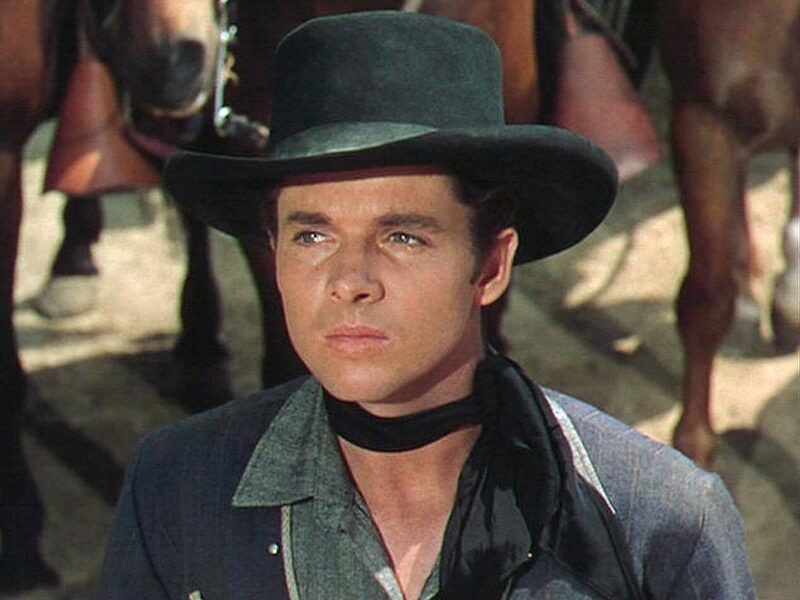Sierra (1950) / Kansas Raiders (1950) / Destry (1954)
BLU-RAY STREET DATE: JULY 18, 2023/KL STUDIO CLASSICS
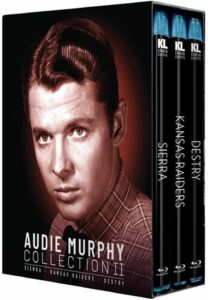
A few years ago, KL Studio Classics opted to release an assortment of three-film Blu-ray sets dedicated to famous actors from the Hollywood’s bygone decades. Much like the label’s popular long-running “Film Noir” sets (and the sadly abandoned Western Classics collections), the included titles range from unearthed gems to the previously overlooked; from the unjustly forgotten to- let’s face it- the merely so-so. What’s important is that all the titles in question have made their way to physical media. Rock Hudson, Tony Curtis, and Carole Lombard, who netted two such volumes, were the stars of such collections. It’s since become public knowledge that all of those sets sold poorly. The big exception was the one devoted to World War II hero Audie Murphy, the most highly decorated serviceman in U.S. history. That set, we’re told, was in fact quite popular.
Leaning heavily into its access to the back catalog of Universal-International- the studio where Murphy launched his leading man career as a contract player- 2020’s Audie Murphy Collection (volume I) served up a three-course feast of some of the star’s finest efforts. It’s telling that that set favors Murphy’s late-1950’s work, a point by which he’d largely settled into the job, and the studio no longer felt the mandate to make sure he always appeared as the noble hero he was in real life. That set, as I said at the time, is indispensable.
Cut to 2023. KL finally follows up on the popularity of the initial Audie Murphy Collection with volumes II and III, with rumblings about a fourth in the works. Below, I review each of the three discs found in Collection II, Sierra (1950), Kansas Raiders (1950), and Destry (1954). As one can see, this set very much favors the early portion of Murphy’s time at Universal- a time when he was mostly just finding his footing in front of the camera. While it can’t hope to compare fully to the greatness of volume I, the question of how exactly it fares is fair. So, without further lallygagging, here’s our blow-by-blow look at the first follow-up to one of the only good things to come out of 2020, KL Studio Classics’ medal-worthy Audie Murphy Collection:
Sierra
DIRECTED BY ALFRED E. GREEN/1950
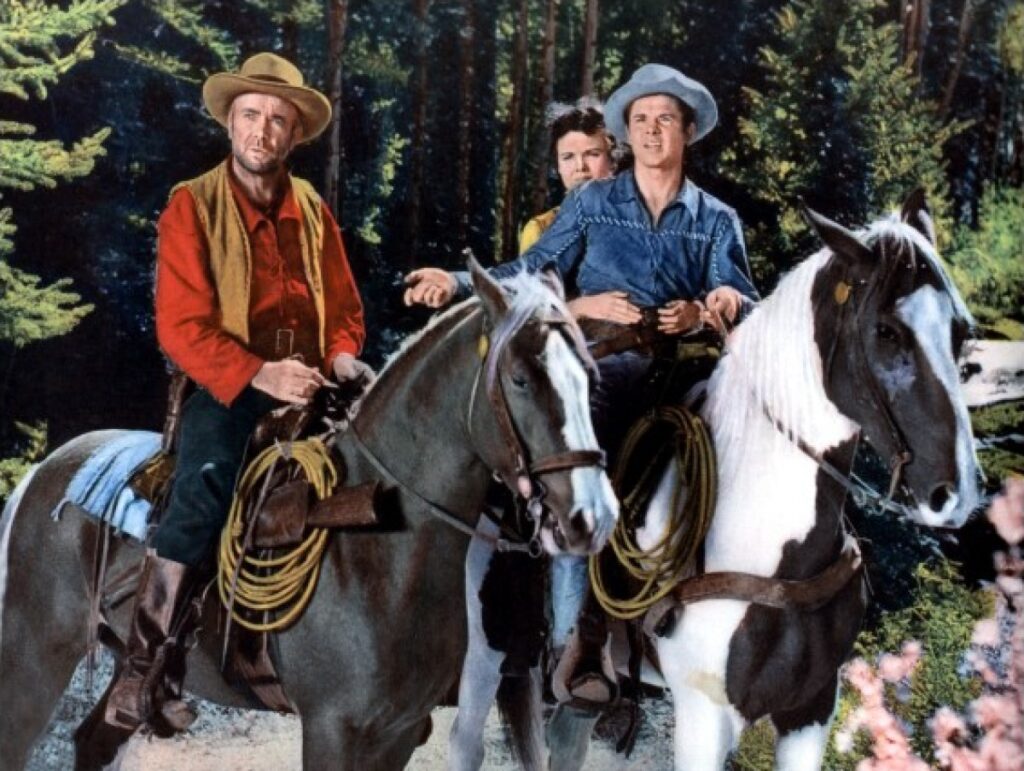
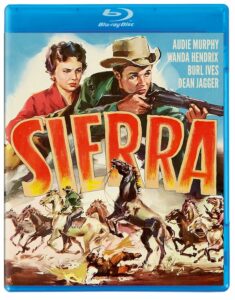
When Audie met Wanda… they got on like a herd of wild horses- fast, rough, unpredictable, but always straight ahead. That’s true for their characters in 1950’s Sierra, a just-fine middle-of-the-road Western salvaged by some awe-inspiring Technicolor location photography (the rocky plains of Utah, filmed courtesy of Universal-International mainstay Russell Metty), a guitar-slingin’ Burl Ives, and a whole lot of galloping steeds determined to run nowhere fast.
Contrary to the listings on the front of KL Studio Classics’ Blu-ray case (which lists her second), leading lady Wanda Hendrix managed to score top billing over rising star Audie Murphy. A year earlier, she also managed to score Murphy himself; the two had wed shortly before Sierra was filmed. They were still married when they shot the movie, but not by the time it hit screens. Perhaps the presumably fraying nature of their real-life union explains why their on-screen chemistry here is entirely basic. When the characters first meet, we simply know that they’ll end up together. Not because they exude such undeniable magnetism, or anything of the sort. Rather, we just know that that’s how innocuous Westerns such as this play out.
Murphy plays Ring, the son of a wrongly charged outlaw (Dean Jagger, who gets to spend most of this movie in bed, wounded) who’s lived most of his life hiding out in the mountains with his father. They harbor a dream of wrangling “the big herd”- a massive pack of wild horses that charge through the hills and valleys as their unshoed hooves please. Whoever catches ‘em gets to keep ‘em… provided they can break ‘em.
One day while Ring is trying to achieve step one in that unlikely process, he discovers Riley (Hendrix) hiding in a nearby bush. Due to plot circumstances, he’s got to take her back to he and his infamous father’s hidden cabin. She’s got to be blindfolded for the ride, which consists of a crazy-steep hillside followed by a sloshy shallow stream, and finally, to an isolated cabin on the edge of a majestic hillside matte effect shot. Even sans eyesight, anyone with a reasonable familiarity of the terrain would likely be able to venture a decent guess as to that route. But never mind that; it ends up not mattering anyway.
It’s revealed that Riley is actually a lawyer, though due to the default chauvinism of the town, she’s yet to be allowed to try a case. (Which makes for a nice opportunity for the film to comment on the suppression of women). That finally changes when Ring ends up having to stand trial for other crap unrelated to his criminal father, who by this point lies in bed back home in danger of succumbing to a horse-riding accident. Because this is a darn tidy little eighty-three-minute programmer, her slick businessman fiancé is actually crooked, and tied to the tragic incident of fifteen years ago that Ring’s father has been blamed for. Whatta snake…. Ring gets a plan, and some unlikely help (look for James Arness and Tony “Anthony” Curtis in early minor roles), but will it be enough to stop the bad guys, wrangle the big herd, and get the girl?
KL Studio Classics’ Blu-ray edition of Sierra displays an above-average if not perfect transfer (color registration doesn’t always line up just right) and clear audio (better to enjoy the geee-tar antics of musician and actor Burl Ives’ character, Lonesome. The disc’s only notable bonus feature is a new audio commentary by film historian Toby Roan. The track isn’t Roan’s best work, as it launches with a very Wikipedia-esque approach to summarizing careers and filmographies, and never truly recovers. Still, most any commentary is better than nothing.
While Sierra never reaches the high highs that one might hope for with a title such as that (Raoul Walsh got there ten years earlier, with Humphrey Bogart and Ida Lupino in tow, to boot), it proves a perfectly fine inclusion in a themed box set such as Audie Murphy Collection II. The leads may not lend much to the proceedings, but Ives with his delightfully silly songs is on hand to compensate. Heck, he’s got the film’s best scene (lulling a deputy to sleep so he can release Ring from jail). Plus, there’s no wrong way to photograph a full-on charging big herd o’ horses in the wild. As a different singer sang, wild horse couldn’t drag us away.
Kansas Raiders
DIRECTED BY RAY ENRIGHT/1950
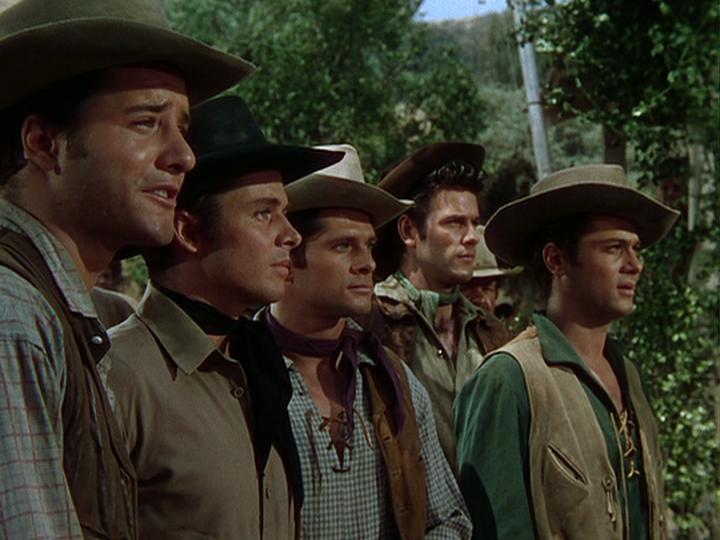
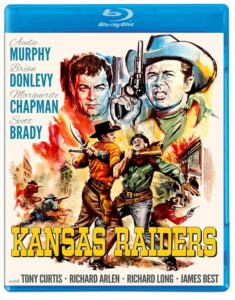
One thing an overage of misplaced male machismo tends to assure is an abundance of action. That’s quite the case for Kansas Raiders, the second of two 1950 Universal-International Westerns included in KL Studio Classics’ three-film set, Audie Murphy Collection II. Whenever there’s a lull, count on punches being thrown, shots being fired, or even whole backlot settlements being attacked. At the very least, mannishly stern words are exchanged.
Murphy stars as none other than young Jesse James as he leads his devoted gang of five (himself, Jesse’s brother Frank [Richard Long], Kit Dalton [Tony Curtis], and Cole and James Younger [James Best and Dewey Martin] to what he’s sure is a greater purpose. That purpose? Swearing allegiance to one William Quantrill (Brian Donlevy), who’s band of raiders has been taking advantage of the chaos of the American Civil War to ransack and loot as they insanely see fit.
Jesse, portrayed valiantly by Murphy, can’t help but be received as an unintentionally conflicted character. Caught between the studio’s likely mandate to play up the actor’s status as an American hero and the real-life outlaw complexity of Jesse James (bolstered, no doubt, by a would-be morally murky screenplay by future blacklisted writer Robert L. Richards), the former concern can’t help but win out. What Kansas Raiders ends up as is a mixed-up mess, where we’re meant to admire and root for Jesse James (of all people) as he gives his unwavering support to the obviously phony Confederate Quantrill (again, of all people), even as he sees Quantrill’s atrocities for what they are, is repulsed by them, and calls him out on them time and again. (Early in the film, Jesse and his gang are nearly lynched after incorrectly being identified as part of Quantrill’s Raiders. So I guess they just decide to make it official?) Yet, even when all the other Raiders have abandoned Quantrill, Jesse and his gang are still riding alongside of him. (Even stranger perhaps, Quantrill’s female significant other, Kate Clarke [Marguerite Chapman], unquestionably sees her man for what he is, and isn’t afraid to let Jesse know. But does she leave him? Noooo…)
It very much seems that there’s a truly interesting potential ethical examination of a movie in here somewhere. As it stands, skilled journeyman director Ray Enright generates a misplaced star vehicle with- I’ll just say it- a fundamentally miscast star. One wonders what, say, Nicholas Ray and James Dean would’ve made of this conundrum of a story. As is, the movie gallops along reasonably well, careening ahead to its ironically morally unsound conclusion on bursts of high-bodycount action. Enright’s camera and varying focal length choreography are impressive insofar as they glaze weak, strained material with pleasing flourishes. This is just as J.J. Abrams does today.
KL Studio Classics’ Blu-ray treatment of Kansas Raiders is a generally very pleasing Technicolor presentation. There is one shot that is glaringly screwy: as the Raiders ride out of the burning town of Lawrence, the optical element with all the fire appears to knock the practical footage horribly off register, the riders looking chroma green and unintentionally psychedelic for an important moment. The source of this weird defect may go back to the original materials, but it is too bad that whatever possible efforts that could be attempted today to repair it were not taken.
On their exceptional audio commentary track, author/screenwriter C. Courtney Joyner refers to this early Western-centric phase of Murphy’s career as his “seasoning.” They discuss how Murphy, in full understanding that he was being quickly groomed into movie stardom by the studio, wanted to be good on screen. Clearly, Murphy is simply following orders, and quite well at that. Too bad that the orders arrived muffled all to hell and back.
Destry
DIRECTED BY GEORGE MARSHALL/1954
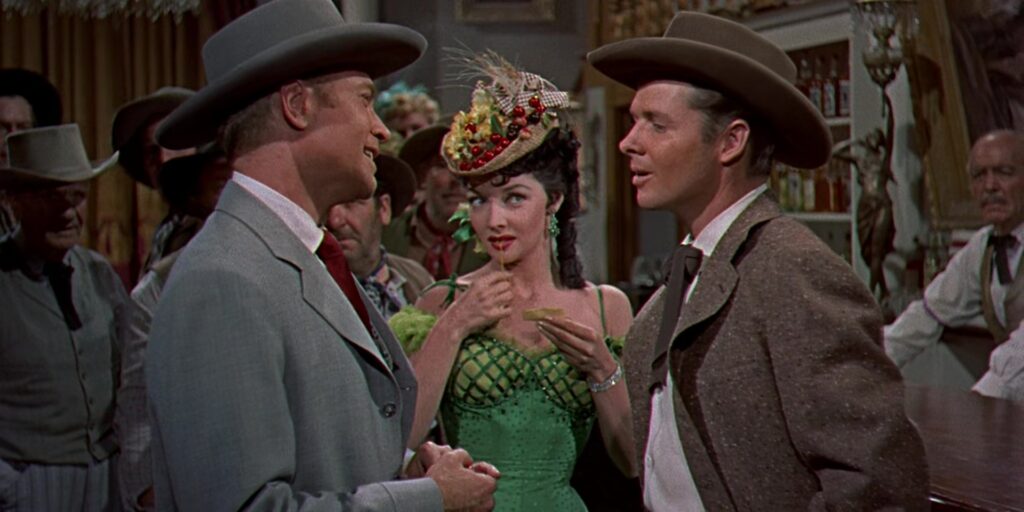
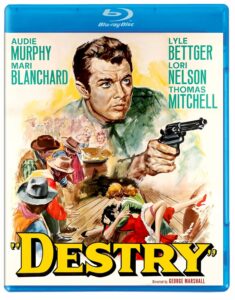
Before Destry, Destry rode again. I know that sounds kind of confusing, but it makes perfect sense. 1954’s Destryis not only a Technicolor revisitation of Universal’s previous theatrical adaptation of Max Brand’s 1930 Western novel, Destry Rides Again, it is in several ways a remake of the 1939 Jimmy Stewart starrer bearing the book’s same title. Both the 1939 and 1954 Destrys were helmed by director George Marshall (an unsung vintage talent behind the camera; Ghost Breakers; Fancy Pants), the latter one starring Audie Murphy in the title role.
Unlike its two Blu-ray set-mates in KL Studio Classics’ Audie Murphy Collection II (Alfred E. Green’s Sierra and Ray Enright’s Kansas Raiders; both 1950 releases), Destry, being several years along in the star’s career, finds him with increased confidence and perhaps a loosened overall grip in terms of how he’s depicted. While Murphy’s take on new-in-town deputy sheriff Tom Destry, Jr. is very much reminiscent of Stewart’s 1939 performance, the character remains an anti-gun pacifist who is queer coded upon his arrival- both of which are darn near opposite of war hero Murphy’s persona onscreen and in real life.
Of course, amid the clatter and din of colorful yokels, bored saloon girls, and convincing villains (all portrayed by a small fleet of outstanding character actors, including Edgar Buchanan, Wallace Ford, Alan Hale, Jr., Mary Wickes, George Wallace, Richard Reeves, and more) there’s a reoccurring message that first impressions are not to be trusted. And, sure enough, Destry is a crack shot and good in a fight. He simply prefers to talk things out whenever possible, operating like a cunning police detective rather than a hired gun. He loyally serves under the drunken auspices of Rags, Thomas Mitchell’s straw man sheriff, while methodically working to bring down the town kingpin, Decker (Lyle Bettger in a shiny gold vest).
Film critic/author Lee Gambin and actor/film historian Gary Frank provide a really great commentary track, one that’s both continuously interesting and a pleasure to listen to. I don’t know how often if ever Gambin and Frank have previously teamed up, as they do engage the material from different points of view. That it only takes them about ten minutes to adjust from their separate tracks (Frank likes to narrate what’s onscreen with infusions of solid background info; Gambin veers more to thematics and bigger all-around ideas) to an active collaboration speaks volumes about their professionalism and ability to pivot on the fly. The commentary is the disc’s only extra aside from the film’s trailer, some other trailers, and optional English subtitles, if any of that counts.
Having basically remade his own earlier movie, George Marshall sits among a relatively small cadre of fellow directors who’ve also done so, such as Alfred Hitchcock and Michael Haneke. While he had Marlene Dietrich as the duplicitous saloon singer in his original (though his original was not THE original, as cowboy star Tom Mix beat everyone to playing Destry with his 1932 adaptation), Marshall does actually manage to up the sexy factor with Mari Blanchard in the role playing it bold and feisty. Blanchard and Mary Wickes have one of the most epic “cat fights” in Western film history, resulting in doused hairdos and tattered dresses- not to mention eyes of fire! One thing’s for sure: Marshall’s more risqué approach gives a whole other meaning the screenplay’s term “promiscuous shooting.”


